
Recognizing Impetigo
Impetigo infection varies between each individual. Some may develop clear fluid-filled blisters that cluster, while others may develop blisters in a line. It is very common for a person who comes in contact with a contaminated surface to have their palms and fingers afflicted. The size of the infection also varies. Some people may only develop tiny blisters-while others may present large patches or boils.
Doctors can generally make a diagnosis simply by visual examination. Some doctors choose to do a wound culture. Fevers do not present with impetigo, but lymph nodes may be swollen near the area.

Treating Impetigo
Children are often given antibiotic ointments for the impetigo. If the infection is more severe, oral antibiotics may be prescribed. Children are asked to stay home from daycare and school for at least twenty-four hours after they start antibiotic treatments.
All wounds should be gently washed with soap and water and covered with a light airy dressing. This will absorb any drainage and help keep tiny fingers from scratching the sores.
Complications from impetigo are rare. If a complication does occur, it’s probably due to an infection that developed from excessive scratching at the area.

Special care needs to be taken when a child develops impetigo. The infected child’s clothing, washcloths, and towels need to be washed separately, preferably at the hottest setting the clothing will tolerate. Hands need to be washed frequently and thoroughly. It might be a good idea to use hand sanitizer and a disinfecting household spray, but do not use hand sanitizer on your child if they have blisters or sores on their fingers and hands. Towels and other items should not be shared, and children should be encouraged not to scratch.
The bacteria that cause impetigo can easily enter broken skin. You should monitor your child’s cuts and scrapes and keep them clean. Impetigo can occur with healthy skin also.
If you suspect your child has impetigo, call their pediatrician. Many impetigo infections clear up on their own, but if your child is in a daycare setting or school, you’ll want to seek treatment to help prevent the spread to other children.
Many people believe that impetigo spreads from poor hygiene. This is not true. You and your child should not feel ashamed if impetigo develops. While frequent bathing and hand washing are imperative to good health, developing impetigo is by no means an indicator of uncleanliness.
© Rebecca Pillar 2007
